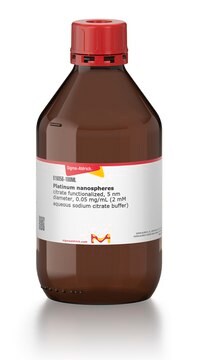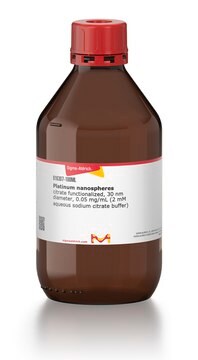773875
Platinum, nanoparticle dispersion
3 nm particle size, 1,000 ppm in H2O, 99.99% trace metals basis
Synonyme(s) :
Platinum colloid, Pt NP, Pt dispersion
About This Item
Produits recommandés
Niveau de qualité
Pureté
99.99% trace metals basis
Forme
dispersion
nanoparticle
Pertinence de la réaction
reagent type: catalyst
core: platinum
Concentration
1,000 ppm in H2O
Taille des particules
3 nm
Densité
0.997 g/mL at 25 °C
InChI
1S/Pt
Clé InChI
BASFCYQUMIYNBI-UHFFFAOYSA-N
Application
Classe de danger pour l'eau (WGK)
nwg
Faites votre choix parmi les versions les plus récentes :
Déjà en possession de ce produit ?
Retrouvez la documentation relative aux produits que vous avez récemment achetés dans la Bibliothèque de documents.
Les clients ont également consulté
Articles
Electronically, it behaves as a wide band gap (3.2 eV) semiconductor and exhibits memristor properties.2 Optically, TiO2 has high opacity with a very high refractive index3 (>2.4), and it exhibits strong absorbance in the UV range.
The production of hydrogen by catalytic water splitting is important for a wide range of industries including renewable energy petroleum refining and for the production of methanol and ammonia in the chemical industry.
The past several decades have seen major advancements in the synthesis of metal nanomaterials. Most recently, controlled synthesis has become versatile enough to regulate the exact number of atoms and ligands of very small metal nanoparticles, referred to as “clusters”.
The past several decades have seen major advancements in the synthesis of metal nanomaterials. Most recently, controlled synthesis has become versatile enough to regulate the exact number of atoms and ligands of very small metal nanoparticles, referred to as “clusters”.
Notre équipe de scientifiques dispose d'une expérience dans tous les secteurs de la recherche, notamment en sciences de la vie, science des matériaux, synthèse chimique, chromatographie, analyse et dans de nombreux autres domaines..
Contacter notre Service technique





